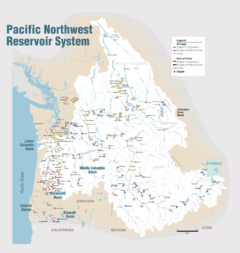| Arrowrock Dam | |
|---|---|
 Aerial view from the west | |
Location in Idaho | |
| Country | United States |
| Location | Boise and Elmore counties, Idaho |
| Coordinates | 43°35′44″N 115°55′20″W / 43.59556°N 115.92222°W |
| Purpose | Irrigation |
| Construction began | 1911 |
| Opening date | 1915[1] |
| Owner(s) | U.S. Bureau of Reclamation |
| Dam and spillways | |
| Type of dam | Arch dam |
| Impounds | Boise River |
| Height | 350 feet (107 m)[1] |
| Length | 1,150 feet (351 m)[1] |
| Reservoir | |
| Creates | Arrowrock Reservoir |
| Total capacity | 300,850 acre-feet (0.371 km3)[1] |
| Catchment area | 2,200 square miles (5,700 km2)[1] |
| Surface area | 3,100 acres (12.5 km2)[1] |
| Normal elevation | 3,210 ft (978 m) AMSL |
| Power Station | |
| Operator(s) | Boise Project Board of Control[2] |
| Commission date | March 2010[2] |
| Installed capacity | 15 MW[2] |
 | |
Arrowrock Dam | |
| NRHP reference No. | 72000437 |
|---|---|
| Added to NRHP | 1976 |


Arrowrock Dam is a concrete arch dam in the western United States, on the Boise River in southwestern Idaho, east of Boise. Opened 109 years ago in 1915, it is located on the border of Boise and Elmore counties, upstream of the Lucky Peak Dam and reservoir. The spillway elevation for Arrowrock is 3,219 feet (981 m) above sea level and its primary purpose is to provide irrigation water for agriculture.
The dam was designated as a National Historic Civil Engineering Landmark by the American Society of Civil Engineers in 2016,[3] and is operated by the U.S. Bureau of Reclamation.
- ^ a b c d e f Arrowrock Dam Archived 2012-03-12 at the Wayback Machine, NPDP Dam Directory
- ^ a b c Arrowrock Dam, US Bureau of Reclamation
- ^ Ross, Anette (2016-09-09). "Arrowrock Dam Recognized as Historic Civil Engineering Landmark" (Press release). U.S. Bureau of Reclamation. Retrieved 2021-02-05.

